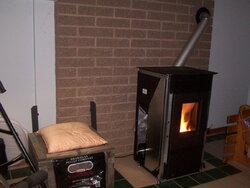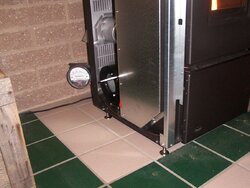Apologies in advance for what will become a long thread I'm sure, since I'm a pretty vocal guy LOL.
After much research here and elsewhere I finally found the only stove that met all my intentions, the Maxx-M. Well, really the Maxx would also but I wanted the flexibility to try other fuels, especially since I've noticed the pellet market can fluctuate a bit.
My house came with a beautiful enameled wood stove in a nicely finished basement room, and a nice enough wood insert in the upstairs 'great room'. The basement wood stove will not draft properly, as I found during the 9-day ice storm/power outage 6 months after moving in. Took a few years to get the plan moving but replacing the wood stove with a pellet stove, given outside air and forced exhaust, seemed like the right answer. Next problem is that making that basement room hot doesn't do much for the area of the house we spend most of our time in, so the Maxx's duct kit and a little work seems like a fix.
Anyway with the stove chosen talking with a couple installers all insisted on stainless liner for my perfect condition chimney. My building inspector didn't think that was required, and given the cost of the liner I figured it was worth a try. So off I go installing it myself.
Wound up with 4" Excel Pellet vent going to my 6" masonry adapter, where I convert to flex and go 2 feet in and make a cut off 90 degree turn, kind of like a frenched exhaust tip. I am not happy with the 8 joints needed to get it out-and-up but that's how it's done. I was ready to go off-book and get some stainless bent- and welded-up, especially since my building inspector was not requiring double wall pipe (which is just replacing the single-wall stove pipe that was in place for the wood stove). But I understand the need for UL listing and gave it a go. I know, pics or it didn't happen!
Since I had concerns about the chimney venting and the local installer didn't use a Magnehelic gauge I picked one up on eBay for $40 or so, nabbed the Dorman oil pressure gauge kit from RockAuto (suggested here, thanks!) and plumbed it in - see 2nd pic. Draft is AOK on my test burns so far, with 0-degree cold stack or windy day not posing any problems - I am able to get the proscribed WC no problem.


You might notice I've added aluminum screen to the back panels using a 3M high temp double-sided tape I got from DigiKey. This is because the Maxx, like almost every other pellet stove, has no provision for filtering room air and I have a dusty house plus a long-haired cat. At least with this stove I can do this - another reason I went this way. Another thing I did was to polish the sheetmetal hopper along the bottom to better help the pellets slide down - used some Zaino and it seems to help. I have since re-lengthed the exhaust and centered the stove in that tile floor detail LOL, but I do need to raise the stove 1/4" or so to get the length perfect. I got some hard rubber feet to go under the factory pieces.
My next two issues are a little trickier.
I intend to take outside air through the wall seen on the stove's right, but have some issues getting through that wall. More on that later. For now though the vexing thing is I did not want to use the usual 3" flex pipe as I think it would be tough to get the tight radius I want and also think it would wind up looking kind of crappy, besides conducting cold from the outside. So I found some pre-bent 3" exhaust pieces and a sleeve to go over the stove's inlet. Problem is, even though this is thin-wall (1/16th I think) pipe, coming straight back to the notch in the rear panel interferes with the cooling fan on the auger motor. I guess when using flex they would just deform it - I will have some trouble doing a good job of that on my 3" steel pipe. I thought about using 6" of the flex stuff to get past the auger but really want the fixed location to help support the weight of the intake. Wish me luck as I figure out how to support a 3" round pipe while crushing it in a controlled fashion.
Then there's managing shut-down during a power failure. A UPS will give me both the surge protection needed and will keep the exhaust blowing through a shut-down but man oh man it's going to take a big unit. I used a clamp meter and it takes a pretty consistent 3A for 1/2 hour. That's a stout UPS. I am debating using a more affordable one that should go 15 minutes, which seems to be 80% of the exhaust problem even from high, but that spec is for a new unit and I would bet it falls to 10 minutes after a couple of years. Then there's my next surprise, these stoves almost all lack a planned way to tell it to shut down. I thought about putting a relay across the overtemp but my dealer points out that takes a reset to clear, and I might be better off intervening in the vacuum circuit instead. As a test I tried a vacuum shutdown and it seems like that needs a user reset to re-start as well. Maybe I'll have to piggy-back on the thermostat circuit instead... Hmmm...
Thanks for listening, and catch you later!
- Jeff
After much research here and elsewhere I finally found the only stove that met all my intentions, the Maxx-M. Well, really the Maxx would also but I wanted the flexibility to try other fuels, especially since I've noticed the pellet market can fluctuate a bit.
My house came with a beautiful enameled wood stove in a nicely finished basement room, and a nice enough wood insert in the upstairs 'great room'. The basement wood stove will not draft properly, as I found during the 9-day ice storm/power outage 6 months after moving in. Took a few years to get the plan moving but replacing the wood stove with a pellet stove, given outside air and forced exhaust, seemed like the right answer. Next problem is that making that basement room hot doesn't do much for the area of the house we spend most of our time in, so the Maxx's duct kit and a little work seems like a fix.
Anyway with the stove chosen talking with a couple installers all insisted on stainless liner for my perfect condition chimney. My building inspector didn't think that was required, and given the cost of the liner I figured it was worth a try. So off I go installing it myself.
Wound up with 4" Excel Pellet vent going to my 6" masonry adapter, where I convert to flex and go 2 feet in and make a cut off 90 degree turn, kind of like a frenched exhaust tip. I am not happy with the 8 joints needed to get it out-and-up but that's how it's done. I was ready to go off-book and get some stainless bent- and welded-up, especially since my building inspector was not requiring double wall pipe (which is just replacing the single-wall stove pipe that was in place for the wood stove). But I understand the need for UL listing and gave it a go. I know, pics or it didn't happen!
Since I had concerns about the chimney venting and the local installer didn't use a Magnehelic gauge I picked one up on eBay for $40 or so, nabbed the Dorman oil pressure gauge kit from RockAuto (suggested here, thanks!) and plumbed it in - see 2nd pic. Draft is AOK on my test burns so far, with 0-degree cold stack or windy day not posing any problems - I am able to get the proscribed WC no problem.


You might notice I've added aluminum screen to the back panels using a 3M high temp double-sided tape I got from DigiKey. This is because the Maxx, like almost every other pellet stove, has no provision for filtering room air and I have a dusty house plus a long-haired cat. At least with this stove I can do this - another reason I went this way. Another thing I did was to polish the sheetmetal hopper along the bottom to better help the pellets slide down - used some Zaino and it seems to help. I have since re-lengthed the exhaust and centered the stove in that tile floor detail LOL, but I do need to raise the stove 1/4" or so to get the length perfect. I got some hard rubber feet to go under the factory pieces.
My next two issues are a little trickier.
I intend to take outside air through the wall seen on the stove's right, but have some issues getting through that wall. More on that later. For now though the vexing thing is I did not want to use the usual 3" flex pipe as I think it would be tough to get the tight radius I want and also think it would wind up looking kind of crappy, besides conducting cold from the outside. So I found some pre-bent 3" exhaust pieces and a sleeve to go over the stove's inlet. Problem is, even though this is thin-wall (1/16th I think) pipe, coming straight back to the notch in the rear panel interferes with the cooling fan on the auger motor. I guess when using flex they would just deform it - I will have some trouble doing a good job of that on my 3" steel pipe. I thought about using 6" of the flex stuff to get past the auger but really want the fixed location to help support the weight of the intake. Wish me luck as I figure out how to support a 3" round pipe while crushing it in a controlled fashion.
Then there's managing shut-down during a power failure. A UPS will give me both the surge protection needed and will keep the exhaust blowing through a shut-down but man oh man it's going to take a big unit. I used a clamp meter and it takes a pretty consistent 3A for 1/2 hour. That's a stout UPS. I am debating using a more affordable one that should go 15 minutes, which seems to be 80% of the exhaust problem even from high, but that spec is for a new unit and I would bet it falls to 10 minutes after a couple of years. Then there's my next surprise, these stoves almost all lack a planned way to tell it to shut down. I thought about putting a relay across the overtemp but my dealer points out that takes a reset to clear, and I might be better off intervening in the vacuum circuit instead. As a test I tried a vacuum shutdown and it seems like that needs a user reset to re-start as well. Maybe I'll have to piggy-back on the thermostat circuit instead... Hmmm...
Thanks for listening, and catch you later!
- Jeff
Last edited:


